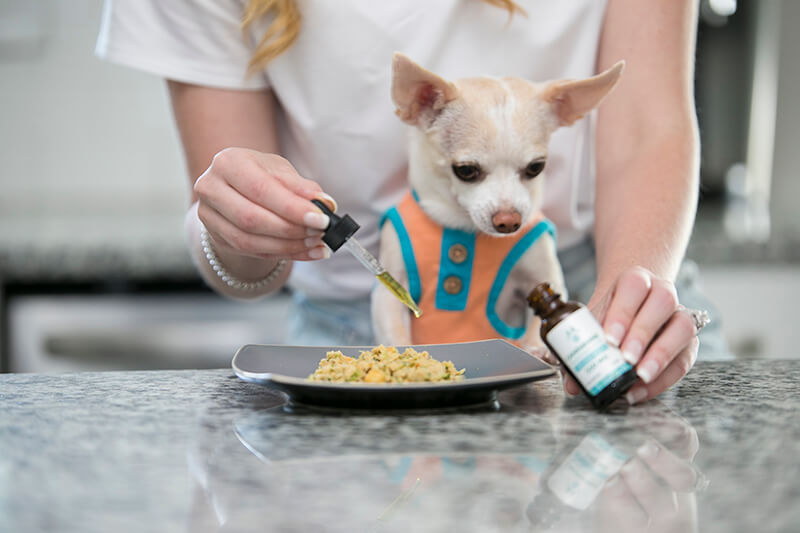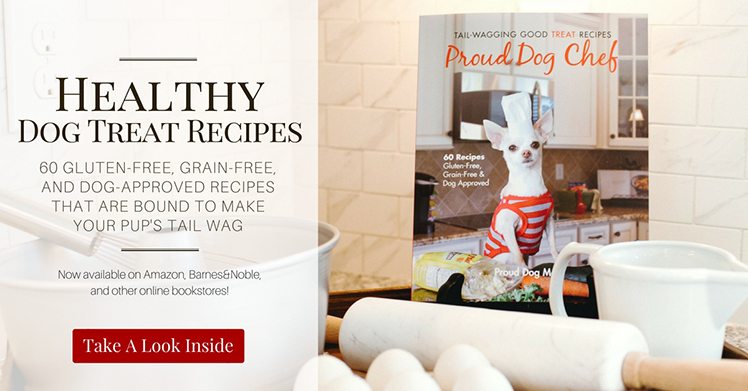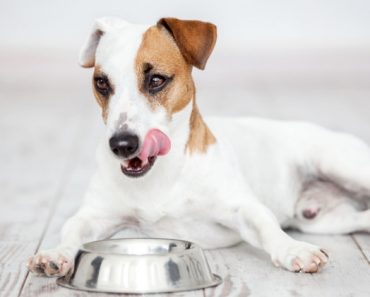Just like people, dogs can get scared, nervous, and anxious. I actually have a good friend whose rescue dog suffers from severe anxiety. The anxiety attacks strike when it rains, thunders, or the wind howls a little too loud. Her dog doesn’t like loud noises and even gets anxious when the vacuum or dishwasher run. As a way to relieve stress, her pooch will pace or try to hide behind furniture. She also rips up clothes and bedding. Despite all of this, she refuses to give her dog anxiety medications. Let me just say, I 100% agree with her. I’m a firm believer in trying the natural route!
When it comes to dog anxiety, there are several things you can do to help comfort and calm your fur baby. Below, I’m sharing 7 tips! But first, let’s take a closer look at anxiety in dogs.
A Little About Dog Anxiety
The first step in easing your dog’s anxiety is pinpointing the exact cause. Anxiety in dogs can be triggered by a number of things.
- Situational/fear-related — meaning your dog is afraid of something specific, like the vet, groomer, car rides, storms, or loud noises. If you have a new shelter dog, his fears are likely deep-rooted from a scarring past experience.
- Behavioral anxiety, like separation anxiety.
Once you pinpoint the exact trigger, work with your dog to help him overcome those fears. In an interview I did with Canine Behaviorist Kathy Reilly, she said:
“Work on changing his mind about particular triggers by associating something good with something scary. In other words, if your dog is afraid of the mailman, try dropping yummy treats as soon as the mailman comes into view and don’t stop until the mailman is gone. With each practice, you will see your dog react less and less. This is because you have changed the association with the mailman. He is no longer a threat but a predictor of yummy treats. Over time, you will need fewer and fewer treats because your dog no longer fears the mailman.”
Similarly, if your dog is afraid of an object, like the vacuum for example, then turn it off and leave it nearby as you feed your pooch a yummy meal or toss him a few treats. Reward good behavior!
If your pup is experiencing separation anxiety, check out this interview I did with certified dog trainer Amber Aquart.
As you work with your dog to change the root behavior, the tips below can help bring some ease to your anxious pup.
Signs of Dog Anxiety
- Barking or crying
- Restlessness, pacing
- Excessive panting
- Shaking
- Chewing or destructive behavior
- Having accidents / Going to the bathroom in the house
- Aggression
- Excessive licking
- Loss of appetite, refusal to eat

7 Ways To Naturally Calm An Anxious Dog
1. Exercise & Brain Games
Before your pup experiences a stressful situation (AKA a trip to the vet, groomer, or car ride), it’s great to squeeze in some exercise and brain games. Going for a walk around your community, playing frisbee, throwing the ball for a game of fetch, or playing with an enrichment toy will help tire out your pooch and act as a great stress reliever for two main reasons. It:
- Stimulates the production of serotonin, a feel-good brain chemical
- Gets rid of pent-up energy that can make an anxiety attack worse
2. CBD Oil
If you’re a regular reader here at Proud Dog Mom then you know I’m a fan of CBD for dogs. I’ve been giving it to my Chihuahua, Diego, for a couple of years and have noticed three major improvements: He no longer seems bothered by joint pain, it’s soothed his seasonal allergies, and his mood has drastically improved.
So how does this liquid gold work exactly? Well, it’s all about the endocannabinoid system (ECS). I know … it may sound strange that we have an entire biological system named after cannabis! That’s because it was first discovered in the early 1990s when scientists were exploring the cannabis plant. So, what is the ECS exactly? Well, let’s breakdown the word:
- “Endo” means “within”. This tells us it’s produced naturally within the body.
- “Cannabinoid” refers to cannabis.
So “endocannabinoid” simply means cannabis-like substances that naturally occur within the body.
The ECS is made of three parts:
- Endocannabinoids
- Receptors – There are two types (CB1 and CB2) which are found in the brain, organs, nerves, and immune system. These receptors regulate many important functions.
- Enzymes that break down endocannabinoids and cannabinoids.
According to Dogs Naturally Magazine:
“Your dog’s body releases endocannabinoid chemicals on its own. These connect with the receptors that stimulate the natural ability to create serotonin. Serotonin is a natural mood stabilizer. Research shows that CBD increases this ability. It interacts with the nervous system to soothe and calm anxiety.”
I give Diego the Cannanine brand and trust it completely. It’s an organic, full-spectrum oil that’s manufactured in the USA from Colorado-grown hemp. It’s been tested and found to be free of heavy metals, harmful bacteria, yeast, mold, and other toxins. Plus, there’s zero THC. Check it out HERE!
I give Diego a dose every morning with his breakfast. Check the bottle for proper dosing.
3. Dog Appeasing Pheromone (DAP)
DAP is a synthetic chemical that’s based on a hormone produced by lactating female dogs. It’s this hormone that helps keep puppies calm. While scientific studies show DAP works with puppies, researchers say it’s unclear if DAP works with anxious adult dogs. DAP has helped calm my friend’s dog and it’s definitely worth a try!
DAP comes as a plug-in diffuser with vials that last for 30, 60, or 90 days. Don’t worry about these synthetic pheromones stinking up your house — humans can’t smell it. Plus, there is also a spray bottle, perfect for travel!
4. Lavender Essential Oil
Lavender is known as the ultimate calming agent and could help your dog beat stress. Many dog moms swear that simply rubbing a little essential oil on their dog’s coat helped calm them down during a storm or car ride. But don’t take my word for it. The effects were put to the test in 2006 during a clinical study that examined 32 dogs with a history of travel-induced excitement. The results? Dogs spent significantly more time resting and sitting and less time moving and vocalizing when exposed to the lavender scent vs no scent at all. Before using essential oils on your dog, make sure to dilute them with a carrier oil — such as coconut, almond, or olive oil.
5. Calm Music
Music can be extremely effective in calming your anxious dog. While you can simply turn on Pandora and play soothing music, there are playlists designed specifically for calming dog anxiety. For example, the company Through a Dog’s Ear offers a selection of pet-calming tunes. It comes pre-loaded with 4 hours of clinically-tested music.
6. Thunder Jacket
A thunder jacket is a lot like swaddling a baby. The tightly wrapped garment applies pressure to your dog’s body, promoting a cuddly and secure feeling. This continuous pressure is believed to calm an anxious dog’s nerves!
7. Dog Massage
It’s no secret that most dogs love to be pet, scratched, rubbed, and massaged. Heck, when I stop petting my pups they immediately reach their paw out and start scratching my hand. It’s their way of saying, “Don’t stop! Keep going!” Along with feeling great, did you know a regular massage provides many health benefits to your pooch? Along with improving blood circulation, aiding digestion, and relieving muscle tension, a canine massage can actually promote relaxation and ease anxiety! In THIS article, I share a great how-to video, showing you exactly how to give your pooch an amazing massage.
*Note: If your dog suffers from severe anxiety, you should consult with your vet.











I have a non profit that helps families find the right new family member for them as well as help if behavioral issues come up after adopting. I have rescued hundreds of dogs because my dad did. And I learned from him. We had every problem under the sun and I learned how to rehabilitate them and then find them good homes. For years we rescued Schiperkees, but after our last past away at 14, we research for the right ones for us at this stage of life and have 2 shih tzus, one is 7, Coconut, and pe’pe is 6. That is a little of my background.
A couple of things to possible add to the list are as follows. One to do is if you are away, put an unwashed t shirt of yours in their Bed or crate. Keep there. Also, get a toy they have to figure out to get at the treats. I recommend blue b… wilderness ones because they are small but nutrious and wont put weight on them
They only get it when you leave. If that isnt in your budget, get a kon…. toy and put peanut butter in it and freeze it. Again it only comes out when you leave. When get home put the toys away for the next time you leave. I also believe in having two dogs, that way they are not alone, but I realize that is not always possible, so maybe they have a doggie fried that can come over some of the times you are away. I also check weather and if i plan to be gone, I use homeopathic drops you get at a organic food store called Rescue Remedy, If a storm is possible. If I am home and storms come we crawl into Bed as long as I am calm and assertive, they feel safe and they are fine without the drops. The key is act nonchalant. Do not baby them, that makes the problem worse. They are dogs and have different needs. They aren’t meant to be babies. When the do well that is when to give attention.But you can use them even when you are home. First, don’t cuddle your dog and feel sorry. They look to you for guidance, you are alpha Dog. I ignore what is going on so they know I’m in control. This will take time, but be patient the reward for them is awesome. Thunders hurts are great but expensive. I take an old comforter and wrap it tight around there midsection and hold them close to your body, works everything. Just make sure you can fit two fingers so it isn’t too tight. I hope this helps, I loved your tips and hopefully many dogs become stress free. There are other things you can do, but I digress. Thank you putting this out there and helping guardians and there angels to be less anxious.
Thanks so much for sharing! Love the tips 🙂